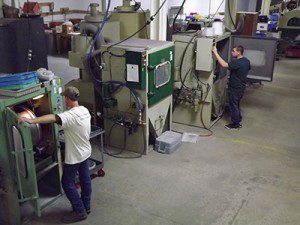With the current technology available, there are seemingly endless types of aluminum finishes to choose from. At RP Abrasives, our mechanical finishes and pretreatments are some of our most popular services, and for good reason. These services fall into two broad categories: finishes that make the part ready for use and finishes that make the part ready to receive a specialized coating.
These finishing services are essential in the best possible outcomes for your aluminum applications, though as noted, they are not the only metal finishing options available in the industry.
Mechanical Finishes
RP Abrasives proudly offers precision mechanical aluminum finishes for aluminum and all metals, including finishing techniques such as bead blasting, tumbling, dual-action (DA) sanding, and polishing/buffing.
Bead Blasting
Bead blasting (our most popular service), or abrasive blasting, are similar blasting services that truly depend on the application. Abrasive blasting generally creates a coarser finish, whereas bead blasting results in more uniform and finer surface texture. These non-reflective or matte finishes are useful in many settings from surgical instruments to a semiconductor to undersea to defense applications to name a few. At RP Abrasives, we use a variety of media which come in a variety of grit sizes.
Buffing
Our aluminum buffing technique is done by using a non-aggressive media that simply tumbles over the product to achieve the desired surface finish, which replicates a polished chrome. This is automated, ‘lights out’ process that works very well on small, complex-shaped parts.
Tumbling

Aluminum tumbling can be done a couple of ways – at RP Abrasives, we offer high-energy tumbling and vibratory tumbling. High-energy tumbling requires placing the parts, abrasive media, water, and surfactant into a barrel with a closed lid. When it’s tumbled, the powerful force is what quickly achieves desired finish. Vibratory tumbling uses friction, or vibrating media, to smooth aluminum.
Each of these offers varying surface textures, from shiny and mirrored to rough or patterned. Consider the above types of mechanical finishing processes alone or in combination to enhance your products finished outcome:
Pretreatment
Have you ever had your car sprayed down before being sent through a car wash? That is the same idea as pretreatment, which is the process of removing soils and other contaminants in order to prepare metal parts for better surface finishing.
Pretreatments enhance not only how well coating adheres to a surface but also reduces the rate of surface corrosion. An effective pretreatment truly depends on high-quality chemical formulations to properly remove all soil from the surface of aluminum or other metals.
Bright Dipping
Bright dipping is a treatment that combines strong acids to remove heavy deposits or oxides from the surface of raw aluminum. In addition to helping remove burrs and other surface defects, bright dipping can also create a range of surface textures – depending on the metal and finishing process used, bright dipping can produce anything from matte to bright and lustrous finishes.
Anodizing
Anodizing is an electrochemical finishing method that forms a layer of oxide on the surface of a metal, thus increasing corrosion resistance. By reducing the amount of wear-and-tear on aluminum parts, it also offers better adhesion for primers, paints, and glues. Other metals can be anodized, but aluminum is the best fit for this type of finishing. Anodizing is one of the most common chemical finishings that we pretreat materials for.
Liquid Paint
Liquid paint is a common choice for various industrial applications, especially ideal for parts that cannot withstand high temperatures that are required for other finishing techniques, such as powder coating. It’s flexibility to apply to various tolerances (where paint can be applied thicker or thinner as needed) makes for easy use. Colors can even be mixed on-site for a more customized finish, and color-changing can be done quickly.
Powder Coating
Powder coating is a dry finishing process for aluminum. It’s made up of finely ground particles of pigment and resin that, when applied, is delivered through an electrode-fitted spray gun. As the powder passes through it becomes statically charged, allowing it to coat the aluminum and remain until permanently cured.
Powder-coated products are resistant to the following:
- Ultraviolet light
- Extreme weather conditions
- Heavy impact
- Chemicals
- Moisture
Because powder coating is extremely durable and is available in nearly limitless color and texture options, it makes a popular option for aluminum finishes.
Sublimation
The process of sublimation is the changing from solid to gas without the in-between step of liquid. A common example of sublimation is dry ice, which transforms from a solid to carbon dioxide without getting wet.
The sublimation coating process is essentially an “iron-on” coating – you take the paper with the dyes or inks that you want as your coating, press them to your application, and apply heat. Once heated, the dyes you used to turn to gas and are absorbed onto the surface of your application.
As you can see, there are a variety of surface treatment options to choose from. Want to know which may be the appropriate finish for your unique application? To learn more about the best of our high-quality aluminum finishes and pretreatments, contact the experts at RP Abrasives today.
